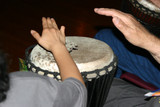History and Rhythms of Claves
Claves are one of the most basic instruments that can be found in almost all cultures. However, the two wooden sticks or dowels, struck together, are mostly attributed to the Cuba and its music. The rhythmic Rumba Claves and Son Claves are the backbone of Latin American music today, including Salsa and Mambo, and were named for the instrument used to create the rhythms.
Since the introduction of African slaves into Cuba during the 16th and 17th centuries, much of Cuban and Latin American music was influenced by the African rhythms and songs that slaves brought with them. The claves were originally thought to have been created by these slaves as they worked in the shipyards of Havana by using the wooden pegs used in the repair or construction of ships. Since much of the music during that time had no written instructions in terms of how to play it, the claves were an important part of establishing a more organized way of keeping a standard rhythm throughout the songs.
Playing Claves is somewhat more complex than it may appear. Striking one stick with another in a rhythmic pattern is just the beginning, and it can take a lot of practice to learn how to modulate the sounds as well as learn the different claves rhythms. Claves can come in many forms, from regular dowel shapes, to sets that are carved at the ends or in the middle, helping the sound quality when held in the hand.
PulseWave.com explains, “All clave patterns have 5 strokes, three of which are in one half of the pattern and two in the other half of the pattern. The strokes in one half are not played in the other. This fact is basic to the feeling of the clave. Each half of the pattern has it own momentum. The placement of the three strokes in the first half is in great contrast to the two strokes in the second half. The first half has a suspended, off beat feeling and the second half has a resolved, on beat feeling.” Claves can be heard in Columbia, Merengue, Guaguanco, Rumba, Conga, Mozambique, Salsa, Iyesa, Bata, Timba and countless other Latin American and African Rhythms. Each of these rhythms also can vary from location to location, tradition to tradition and the percussionist’s own preferences.
Claves, while a simple instrument, is rich in history, tradition and musical importance. They are important to Latin American and African music and traditions, yet, it is easy enough for children to use to learn basic rhythms. Listen for the claves in your everyday music and see if you can pick out the two major rhythms, the Rumba Claves and the Son Claves. You may be surprised where the instrument and its familiar sound end up.
Recent Posts
-
Incorporating the Thumb Piano into Modern Music Production
Introduction to the Thumb Piano The thumb piano, also known as the Kalimba or Mbira, is a small …15th Apr 2024 -
The Top 5 Djembes for Beginners: A Buyer's Guide
What is a Djembe? A Djembe is a type of drum originating from West Africa, traditionally made from …13th Apr 2024 -
Hand Drums 101: Techniques and Tips for Beginners
Introduction to Hand Drums Hand drums come in various shapes and sizes and are played by hand rath …1st Apr 2024



